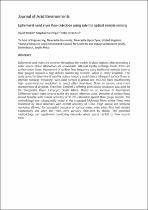JavaScript is disabled for your browser. Some features of this site may not work without it.
- ResearchSpace
- →
- Research Publications/Outputs
- →
- Journal Articles
- →
- View Item
| dc.contributor.author |
Walker, D

|
|
| dc.contributor.author |
Smigaj, M

|
|
| dc.contributor.author |
Jovanovic, Nebojsa

|
|
| dc.date.accessioned | 2019-07-29T12:21:19Z | |
| dc.date.available | 2019-07-29T12:21:19Z | |
| dc.date.issued | 2019-05 | |
| dc.identifier.citation | Walker, D., Smigaj, M. & Jovanovic, N. 2019. Ephemeral sand river flow detection using satellite optical remote sensing, Journal of Arid Environments, vol 168, pp. 17-25 | en_US |
| dc.identifier.issn | 0140-1963 | |
| dc.identifier.issn | 1095-922X | |
| dc.identifier.uri | https://doi.org/10.1016/j.jaridenv.2019.05.006 | |
| dc.identifier.uri | https://www.sciencedirect.com/science/article/pii/S0140196318316045?dgcid=rss_sd_all | |
| dc.identifier.uri | http://hdl.handle.net/10204/11050 | |
| dc.description | Copyright: 2019 Elsevier. Due to copyright restrictions, the attached PDF file only contains the abstract version of the full-text item. For access to the full-text item, please consult the publisher's website. The definitive version of the work is published in the Journal of Arid Environments, vol 168, pp. 17-25 | en_US |
| dc.description.abstract | Ephemeral sand rivers are common throughout the world's dryland regions, often providing a water source where alternatives are unavailable. Alluvial aquifer recharge results from rare surface water flows. Assessment of surface flow frequency using traditional methods (rain or flow gauges) requires a high-density monitoring network, which is rarely available. This study aimed to determine if satellite optical imagery could detect infrequent surface flows to estimate recharge frequency. Well-used sensors (Landsat and MODiS) have insufficiently high spatio-temporal resolution to detect often short-lived flows in narrow sand rivers characteristic of drylands. Therefore, Sentinel-2 offering 10 m spatial resolution was used for the Shingwidzi River, Limpopo, South Africa. Based on an increase of Normalised Difference Water Index relative to the dry season reference value, detection of surface flows proved feasible with overall accuracy of 91.2% calculated against flow gauge records. The methodology was subsequently tested in the ungauged Molototsi River where flows were monitored by local observers with overall accuracy of 100%. High spatial and temporal resolution allowed for successful detection of surface water, even when flow had receded substantially and when the rivers were partially obstructed by clouds. The presented methodology can supplement monitoring networks where sparse rainfall or flow records exist. | en_US |
| dc.language.iso | en | en_US |
| dc.publisher | Elsevier | en_US |
| dc.relation.ispartofseries | Workflow;22425 | |
| dc.subject | Alluvial aquifer recharge | en_US |
| dc.subject | Flow detection | en_US |
| dc.subject | NDWI | en_US |
| dc.subject | Normalised Difference Water Index | en_US |
| dc.subject | Sentinel-2 | en_US |
| dc.subject | Sand river | en_US |
| dc.title | Ephemeral sand river flow detection using satellite optical remote sensing | en_US |
| dc.type | Article | en_US |
| dc.identifier.apacitation | Walker, D., Smigaj, M., & Jovanovic, N. (2019). Ephemeral sand river flow detection using satellite optical remote sensing. http://hdl.handle.net/10204/11050 | en_ZA |
| dc.identifier.chicagocitation | Walker, D, M Smigaj, and Nebojsa Jovanovic "Ephemeral sand river flow detection using satellite optical remote sensing." (2019) http://hdl.handle.net/10204/11050 | en_ZA |
| dc.identifier.vancouvercitation | Walker D, Smigaj M, Jovanovic N. Ephemeral sand river flow detection using satellite optical remote sensing. 2019; http://hdl.handle.net/10204/11050. | en_ZA |
| dc.identifier.ris | TY - Article AU - Walker, D AU - Smigaj, M AU - Jovanovic, Nebojsa AB - Ephemeral sand rivers are common throughout the world's dryland regions, often providing a water source where alternatives are unavailable. Alluvial aquifer recharge results from rare surface water flows. Assessment of surface flow frequency using traditional methods (rain or flow gauges) requires a high-density monitoring network, which is rarely available. This study aimed to determine if satellite optical imagery could detect infrequent surface flows to estimate recharge frequency. Well-used sensors (Landsat and MODiS) have insufficiently high spatio-temporal resolution to detect often short-lived flows in narrow sand rivers characteristic of drylands. Therefore, Sentinel-2 offering 10 m spatial resolution was used for the Shingwidzi River, Limpopo, South Africa. Based on an increase of Normalised Difference Water Index relative to the dry season reference value, detection of surface flows proved feasible with overall accuracy of 91.2% calculated against flow gauge records. The methodology was subsequently tested in the ungauged Molototsi River where flows were monitored by local observers with overall accuracy of 100%. High spatial and temporal resolution allowed for successful detection of surface water, even when flow had receded substantially and when the rivers were partially obstructed by clouds. The presented methodology can supplement monitoring networks where sparse rainfall or flow records exist. DA - 2019-05 DB - ResearchSpace DP - CSIR KW - Alluvial aquifer recharge KW - Flow detection KW - NDWI KW - Normalised Difference Water Index KW - Sentinel-2 KW - Sand river LK - https://researchspace.csir.co.za PY - 2019 SM - 0140-1963 SM - 1095-922X T1 - Ephemeral sand river flow detection using satellite optical remote sensing TI - Ephemeral sand river flow detection using satellite optical remote sensing UR - http://hdl.handle.net/10204/11050 ER - | en_ZA |






